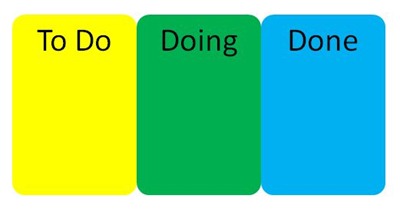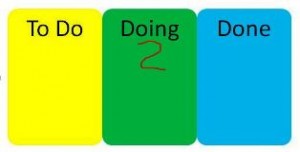Kanban is a lean term and means visual card or sign. It is used to limit the amount of inventory tied up in work in process. Of course in lean excess inventories regarded as ways and so is the time spent in producing it. Kanban scheduling systems are among the simplest, effective and in expensive means for production and inventory control. The concept is proven. It will reduce inventory, eliminate inventory outages, and typically reduce overhead needed to support excess inventory. Many organizations perform Kanban type operations without even knowing it. One of the common examples is the bread truck that drives around in the morning replenishing the shelves based on what has been sold previously.
The marketing Kanban is actually based on a very simple idea. It is based on the idea that managing your work in process or the prospects and customers within your sales cycle effectively will produce a more efficient marketing system. This is not a revolutionary or cutting-edge but the ability of creating visual work in process controls and limiting that work in process will change everything about your marketing.
Marketing Kanban is really about creating the proper cadence or controlling your sales cycle to effectively produce the greatest amount of sales. Understanding your sales cycle time and supporting the bottlenecks that are so visually apparent in a Kanban will make the most effective use of your marketing tactics.
So what does a Kanban look like, the basic structure of it may start out with just three columns: To Do, Doing, and Done.
 This basic visual Marketing Kanban board will be expanded to reach a much greater perspective but always focusing on these five items:
This basic visual Marketing Kanban board will be expanded to reach a much greater perspective but always focusing on these five items:
- Limit work in process by delivering often and focusing on your flow
- Balancing demand and throughput(Find the bottleneck)
- Continuous improvement methods and measurements
- Recognize the right marketing tactics and the minimal marketing features
- Build quality into your system.
How do you achieve this? First you must start mapping your value stream and tracking your work on a whiteboard or some type of software. Do not try a difficult process first try one that you are already using and that you know quite well. You will be surprise how much you can achieve just by the visualization of your work in process. Remember the goal in your first Kanban efforts should not be in changing what you’re doing but creating a cadence or a balanced flow through your system.
The best way to start practicing Kanban is by doing it yourself. Take the last part of today to list all of your tasks that you need to do tomorrow. Put each of them on a separate post it notes. You could even prioritize them with some different colors or even use those colors to represent different clients. But what I would do is to take each of the Post-it notes and put it in the To Do column. As you start, move them across the board from left to right. It is even okay to have several of them in the doing column as you’re waiting on information were other things that may prevent the completion of the task. At the end of the day consider whether it was a positive or I’m not so positive experience. You must remember that a Kanban is just a tool. If you have poor practices, poor quality and poor judgment you’ll probably have a poor Kanban system.
Kanban is not for everyone. A Marketing Kanban system is definitely not for everyone. It takes discipline, time and open-mindedness. You must remember that all processes will change. Corey Ladas, author of Scrumban – Essays on Kanban Systems for Lean Software Development , is famous for saying that he never has created the same Kanban board twice.
Why would you create a marketing Kanban system? Study after study has shown that marketing has become more and more fragmented. The ability to reach your customer with one or even just several marketing tactics is a thing of the past. Both online and off-line content has to be relevant and adapted to a variety of tactics. The ability to do that effectively and within budgetary constraints can only be done by leveling and limiting your work in process. The most effective and proven strategy to accomplish this is the Kanban.
To Do, Doing, Done may not have been an earth shattering experience? The next step is a huge one, and I mean huge. You need to take your drawing and place a number under the Doing Column. Are you shaking yet?
This is how we will manage the Work in Process or the WIP. . If you limit yourself to what you are doing you will be more effective. In Covey’s 4 Disciplines of Execution he states and quantifies the 4 Disciplines:
- Focus on the Wildly Important
- Create a Compelling Scorecard
- Transfer Lofty Goals into Specific Actions
- Hold each other accountable – All the time
Putting just a number on the Kanban board we have done this:
- Putting a limit on the work in process we will determine what really needs to be done.
- Created a scorecard with just having a simple Kanban board.
- Transferred our goals into action as we travel from left to right on the board.
- The board keeps us accountable.
- If this is a board for more than one individual, the tasks that are not being completed will encourage teamwork.
If it is a team effort, using more of a Scrum approach we may ask the same daily questions that are asked by a Scrum Team.
- What have you done since the last meeting?
- What will you do between now and the next meeting?
- What got in your way of doing work?
We may see work piling up in the Doing column without being completing. We may be finding out that we are always reacting to a task in the “To Do” stage versus completing the doing. I know this sound a little childish but on a grander scale it is very much what happens. Just think of a salesperson that never asks for the order. He may be everyone’s best friend but is not getting the percentage of closures that he should. In a Kanban board it becomes readily apparent. The real secret to the board though is that we need to complete the task that is in the “doing” column before we pull from the To Do.
The other feature of using the board is cycle time. In a perfect world, when a task enters the To Do Column it immediately transfer to “Doing.” We complete the task and that would be our cycle time. If there are other tasks in the doing column and a task has to sit in the “To Do” column that time would be added to your cycle time. In Scrum this description is similar to a sprint. In Kanban we even may have different cycle times for different types of customers. This would allow us to create Swim Lanes horizontally across the chart.
Visualization is the key to effective Kanban. You may use different color post it notes to signify different marketing task such as PR, Social Media, Advertising and so forth. You may use different colors in your swim Lanes to recognize different marketing segments. You may even add additional columns to represent your marketing flow. That is actually Marketing Kanban 201.
We are establishing a Work in Process limit to create a proper flow in your marketing. The proper cadence per say. This is a term you will hear me say over and over again. Cadence is a key in today’s marketing which I will demonstrate in a later blog post. The WIP limit is at first, probably a guess. However, establishing one is very important. It is a key to a PULL System. Without, when would you know when to pull?
